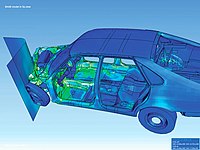
Photo from wikipedia
In this work, a critical comparison between three different numerical approaches for the computational modelling of quasi-brittle structural failure is presented. Among the many finite element approaches devised to solve… Click to show full abstract
In this work, a critical comparison between three different numerical approaches for the computational modelling of quasi-brittle structural failure is presented. Among the many finite element approaches devised to solve the problem, both using continuous and discontinuous methods, the present study examines the relative performance of the XFEM, the mixed strain/displacement FE and phase-field models. These numerical techniques are selected as the current representatives of embedded, smeared and regularized models for analyzing the phenomenon of fracture with different mathematical descriptions for the cracking induced discontinuities in the displacement and strain fields. The present investigation focusses on the main differences of the formulation of these models both at the continuum and discrete level and discusses the main assets and burdens that ensue in their practical application. The relative advantages and difficulties related to their use in the computation of localized structural failure in engineering practice are evaluated against a 10-point checklist that cover the main challenges met by these models. The paper includes an extensive comparison of selected numerical benchmark problems analyzed with the three examined methods. Relative performance is assessed in terms of load capacity, force–displacement curves, crack paths, collapse mechanisms, cost-efficiency and other key issues.
Journal Title: Archives of Computational Methods in Engineering
Year Published: 2021
Link to full text (if available)
Share on Social Media: Sign Up to like & get
recommendations!